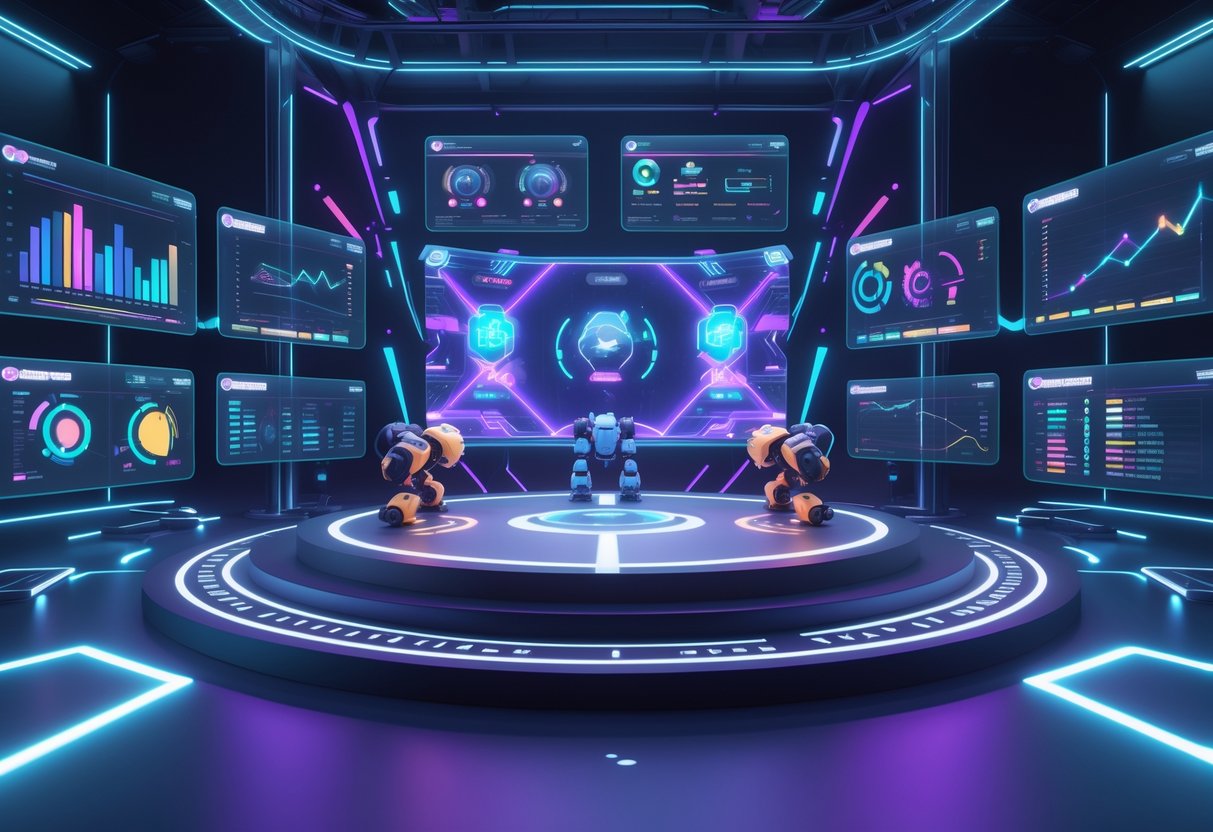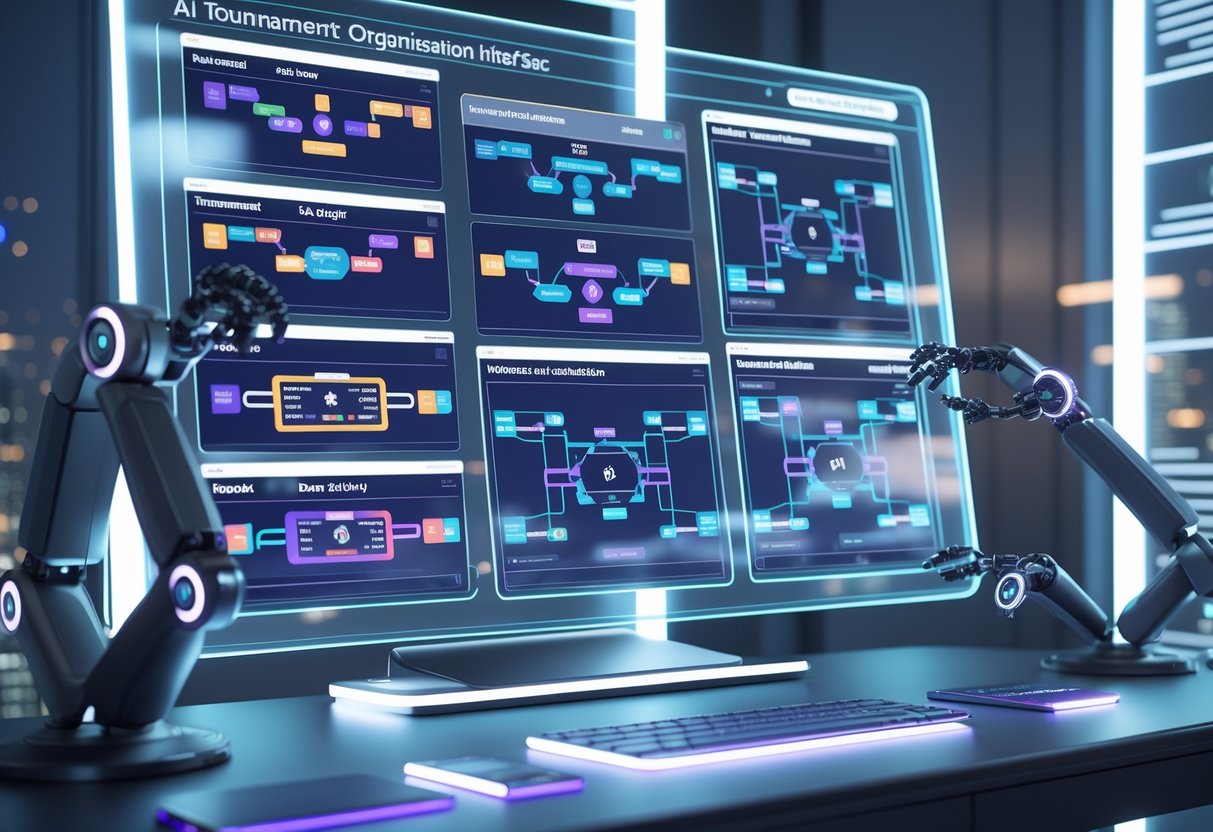AI Tournament Organisation: Modern Strategies & Tools for Success
Updated On: November 13, 2025 by Aaron Connolly
Key Concepts in AI Tournament Organisation

AI’s shaking up tournament management by taking over those tedious scheduling tasks, building smart brackets, and delivering real-time analytics. These days, tournament software leans on machine learning for everything—from registering participants to breaking down post-event feedback.
Evolution of Tournament Management
Tournament organisation changed a lot in the last ten years. We left behind spreadsheets and manual brackets for advanced AI-driven systems.
Back then, organisers spent whole weekends crafting brackets by hand. One schedule change? You’d redo everything from scratch.
Early digital tools made registration and basic brackets easier, but people still had to watch over every detail. Manual updates were just part of the deal.
Modern AI systems now juggle complex variables like:
- Venue availability across different spots
- Team travel times and preferences
- Staff schedules and equipment logistics
- Last-minute delays or dropouts
AI scheduling tools crunch hundreds of variables at once. They find the best match times, reducing conflicts and boosting viewer engagement for streamed events.
If a team drops out at the last minute, AI reshuffles the whole schedule in seconds. No more hours lost to manual fixes.
How AI Transforms Organisation
AI brings smart automation into every part of tournament planning. Algorithms craft brackets that actually factor in past performance and interesting matchups—not just random draws.
Seeding algorithms dig into data like:
- Historical performance
- Current rankings
- Head-to-head history
- Strategic stuff like avoiding early rematches
No more manual score entry. AI pulls results straight from game servers, scorekeeping apps, or even wearables during matches.
Live analytics pop up instantly during tournaments. We get heatmaps, player stats, and dashboards updating on the fly as the action unfolds.
AI chatbots now handle the routine stuff. They answer questions about match times and venues, so organisers don’t have to.
Communication features offer:
- Personal reminders for players and staff
- Instant FAQ responses
- Multi-language help for global events
- Automated posts for social media
Benefits of Automation
Automation genuinely boosts both efficiency and participant satisfaction. Organisers say they save 60-80% of their planning time with AI systems.
Time savings come from ditching repetitive tasks:
- Brackets get built in minutes, not hours
- Schedules optimise themselves
- Scores update seamlessly across systems
- Reports generate without anyone typing in data
Participants get a smoother experience with personalised notifications and real-time updates. AI targets messages based on each person’s role and schedule.
Post-tournament analysis finally feels useful, not overwhelming. AI sorts feedback by topic, sentiment, and urgency.
Analytics break down:
- Social media reach and engagement
- Venue usage and traffic
- Satisfaction scores by group
- Sponsor visibility and brand exposure
AI cuts down on errors. No more double-bookings, scheduling mess-ups, or bracket mistakes.
Organisers get to focus on strategy and building community. The tech handles logistics but doesn’t erase the personal touch that makes events special.
Core Features of AI Tournament Platforms

AI tournament platforms blend automated scheduling and smart communication tools to handle everything—from brackets to player updates. These systems cut down manual work and keep everyone in the loop.
Bracket Generation and Management
AI-powered bracket systems build tournament structures in minutes. The software looks at participant numbers, skill levels, and format preferences to make the best matchups.
Single elimination brackets make sense for big tournaments with tight schedules. Round-robin formats work well for smaller events where every match counts. Swiss system brackets offer a fair and efficient option for medium-sized competitions.
Most platforms let you drag and drop for manual tweaks. Organisers can move players or adjust seeding without starting from scratch.
The AI checks things like:
- Player skill ratings
- Past head-to-head results
- Regional preferences
- Time zones
Heads up: Always double-check AI-made brackets before posting. Sometimes, the software misses context—like rivalries or regional rules.
AI-Driven Communication Tools
Modern platforms use AI to answer participant questions automatically. They keep tournament rules, schedules, and FAQs ready in their databases.
Automated replies cover 70-80% of common questions about match times, venues, and format rules. That takes a big load off admins.
Smart notifications send tailored updates to players. AI knows what info each participant needs, based on their division, schedule, and past questions.
Key features include:
- Instant messaging with auto-responses
- Email templates that change as the tournament progresses
- SMS alerts for urgent updates
- Discord bot integration for gaming groups
The AI learns from past tournaments. It spots trends in questions and suggests new FAQ entries for organisers.
Real-Time Updates and Notifications
AI platforms track tournament progress nonstop and send updates to everyone right away. When a match ends, the system updates brackets, notifies the next opponents, and adjusts schedules automatically.
Push notifications hit players’ phones within seconds of any schedule change. The AI flags urgent updates—like venue changes or delays—so no one misses out.
Smart scheduling notices potential delays and offers solutions. If a match runs late, the system suggests new time slots for those affected.
Notification types include:
- Match start reminders (15 minutes before)
- Bracket progression updates
- Prize announcements
- Technical alerts
Pro tip: Turn on mobile notifications for your tournament app. Players check their phones way more than email during events.
The AI tracks how often notifications get seen and adjusts timing to fit participant habits. That way, critical updates reach people when they’re paying attention.
AI-Powered Scheduling Solutions
AI scheduling systems take the headache out of tournament organisation. These platforms use algorithms to balance venues, team rankings, and coaching conflicts in seconds.
Automated Scheduling Algorithms
Modern AI scheduling engines mimic those in pro leagues. They juggle multiple variables to build the best schedules.
The Rating Percentage Index (RPI) system helps algorithms rank teams fairly. The NCAA uses this method too. It looks at wins, opponent records, and schedule strength.
Key functions:
- Balancing venues with team preferences
- Avoiding coaching conflicts
- Reducing travel distances
- Creating competitive matchups
AI schedules nearly 1,000 teams for a weekend tournament. Doing this by hand would take days. The algorithms track historical data to avoid repeat pairings.
These systems learn as they go. They spot which matchups were the most competitive and use that info to improve future tournaments.
Conflict Resolution Capabilities
Tournament scheduling throws up a lot of conflicts, but AI spots and solves them automatically. The system highlights issues before they become real problems.
Common conflicts AI handles:
- Coaching overlaps: One coach, multiple teams
- Venue double-booking: Two games, same place
- Travel logistics: Teams playing back-to-back at distant venues
- Equipment sharing: Multiple divisions need the same space
The AI makes these conflicts obvious for organisers. It suggests fixes right away. If a venue falls through, the system finds new options that work for both teams.
Smart scheduling stops teams from playing too many games in a row. It also ensures enough rest between matches, which really helps with player fatigue and game quality.
The tech wipes out human mistakes in tricky tournament formats. Organisers can manage round-robins with hundreds of teams—no sweat.
Adapting to Last-Minute Changes
AI scheduling really shines when things change at the last minute. Weather delays, team dropouts, and venue problems get sorted with just a click.
When teams withdraw, the AI instantly rebuilds brackets. It keeps things fair and fills schedule gaps. New teams can even join right up to the wire.
Dynamic changes AI handles:
- Weather cancellations and venue moves
- Team withdrawals or late sign-ups
- Coach availability switches
- Equipment failures needing venue swaps
Live updates push changes to apps and team chats immediately. Parents and players know about schedule changes as soon as they happen.
The system keeps things fair during disruptions. If games get cancelled, AI makes sure no team gets an unfair edge. It recalculates standings and adjusts matchups on the fly.
Emergency rescheduling keeps the tournament on track. Teams still get the right amount of rest and travel time between games.
Accommodating Team Preferences with AI

AI systems gather and process team preferences automatically, then balance those requests with venue availability and logistics. Modern algorithms look at things like preferred time slots, opponent matchups, and travel limits to create fairer tournaments.
Preference Collection Methods
Digital forms and team portals make it easy to collect preferences. Teams submit their available times, match requests, and special needs through these systems.
A lot of platforms use structured questionnaires to capture details. Teams list preferred days, time slots, and blackout periods when they can’t play.
Common preferences:
- Match timing
- Venue location
- Opponent difficulty
- Rest periods
- Travel limits
AI can process hundreds of these submissions at once. That means no more sorting through endless emails or phone calls.
Smart collection tracks patterns over time. Teams that always want morning matches or certain venues get noticed and may get priority in future events.
Personalised Scheduling Techniques
AI algorithms weigh preferences based on team rankings and history. Higher-seeded teams might get more say, while newer teams get standard scheduling.
Machine learning checks past performance to predict the best schedule. Teams that do better with longer breaks get those breaks automatically.
Personalisation factors:
- Skill levels – Different rules for amateurs and pros
- Geographic clustering – Grouping local teams to cut travel
- Performance patterns – Scheduling for peak times
- Equipment needs – Matching teams with similar tech
Dynamic rescheduling lets teams adjust preferences on the fly. If travel delays or player changes pop up, AI suggests new options instantly.
Balancing Team and Venue Needs
Venue limits and tech needs often clash with team preferences. AI uses constraint optimisation to find the best compromise between what teams want and what venues offer.
Priority scoring helps sort out conflicts. Organisers can set rules to put certain preferences ahead, based on fairness.
Balancing strategies:
| Team Priority | Venue Constraint | AI Solution |
|---|---|---|
| Preferred time slots | Limited peak hours | Rotate prime slots fairly |
| Specific opponents | Court availability | Schedule similar matches together |
| Rest periods | Tight scheduling | Optimise breaks |
Real-time tweaks handle last-minute changes. If venues go offline or teams drop out, AI reschedules matches while keeping as many original preferences as possible.
The best systems learn from feedback after every tournament. Teams rate their scheduling experience, and AI uses that to improve next time.
Format Selection and Bracket Customisation

AI tournament generators shine when it comes to building different bracket structures for your needs. These tools use smart algorithms to seed fairly and adapt to surprises during the competition.
Choosing the Right Tournament Structure
Single-elimination brackets really shine when you need a fast tournament. Teams only get one shot, so every match feels intense. This format fits weekend gaming events or small local competitions.
Double-elimination gives teams a second life with losers’ brackets. Players who stumble early can still claw their way back through the lower bracket. You’ll see this format a lot in fighting game tournaments and big esports events.
Round-robin formats make sure every team faces each other once. That’s about as fair as it gets, but it takes way more time. It works best for league-style competitions or qualification rounds.
Swiss system tournaments pair up teams with similar records each round. Nobody gets knocked out early, so everyone stays involved. This setup fits Magic: The Gathering or chess tournaments well.
| Format Type | Time Required | Fairness Level | Best For |
|---|---|---|---|
| Single Elimination | Short | Low | Quick events |
| Double Elimination | Medium | High | Major tournaments |
| Round Robin | Long | Highest | Small groups |
| Swiss System | Medium | High | Card games |
Seeding and Fair Play Algorithms
AI tools now seed players using past performance data. The system pulls rankings from previous tournaments, ladder spots, or custom ratings you give it.
Smart seeding avoids early upsets by keeping the strongest players apart at first. Top seeds land in different bracket sections. This way, the best players don’t meet until later rounds.
Advanced algorithms look at more than just rankings. They consider recent form, head-to-head results, and even regional balance. Some tools won’t let teammates face off right away.
AI deals with last-minute changes smoothly. If a seeded player drops out, the system shuffles things automatically, keeping the bracket balanced and saving you a ton of time.
Quick tip: Always double-check AI seeding before you lock it in. Sometimes local knowledge about player skill beats pure data.
Hybrid and Adaptive Formats
Modern tournaments often mix formats for the best results. Group stages might use round-robin, then switch to single-elimination playoffs. That way, you get fairness and excitement.
Adaptive brackets change with participant numbers. If you plan for 32 teams but only 28 show up, AI tweaks the structure on the fly. It could add play-in matches or adjust seeding for balance.
Some AI tools build dynamic formats that react to time constraints. If you’re running late, the system suggests switching from best-of-three to best-of-one. If you’re ahead, it might add extra qualification rounds.
Progressive elimination drops the lowest performers each round instead of knocking people out instantly. More players stay active longer, which works especially well for battle royale tournaments.
Heads up: Hybrid formats can confuse people. Make sure you communicate any changes clearly before and during the event.
Registration and Entry Management

AI tournament organisation has changed how players sign up and check in for events. These systems group players by skill and handle tricky entry processes that used to take hours.
Streamlined Digital Registration
Modern AI tournament platforms skip the paperwork and long lines. Players just fill out online forms, sharing their skill ratings, preferred formats, and when they’re free.
The system checks entries as they come in. It looks for duplicate sign-ups and makes sure everyone fits the tournament rules. That way, common registration mistakes get caught early.
Key features include:
- Automatic payment and refund processing
- Integration with player databases and ranking systems
- Custom form fields for different tournament types
- Mobile-friendly registration for any device
AI handles hundreds of sign-ups at once. It processes entries way faster than any human team and can cut admin workload by up to 70%.
Skill Ratings and Dynamic Grouping
AI analyzes player skill data to build balanced groups. The system pulls ratings from online platforms, past tournaments, and even self-reported skill levels.
Dynamic grouping lets brackets flex based on who registers. If a bunch of beginners sign up, the AI creates more novice sections. If experts join at the last minute, it tweaks divisions to keep things fair.
Rating sources include:
- Official ranking systems (ELO, Chess.com)
- Tournament history and performance data
- Peer and coach assessments
- Practice session results
This stops lopsided games where experts crush total beginners. Players face opponents close to their own skill, making tournaments more fun for everyone.
On-Site Check-In and Pairing
AI check-in systems use QR codes or mobile apps to log player arrivals. The tech tracks who’s there and updates pairings if someone’s missing.
Real-time pairing engines schedule matches as players show up. Late sign-ups slide into brackets without messing up ongoing games.
Check-in features:
- Instant player verification with photo ID scanning
- Automatic bracket updates for withdrawals
- SMS notifications for pairings and table assignments
- Scorekeeping system integration
The system manages last-minute changes with barely a hiccup. When someone drops out mid-tournament, it recalculates brackets and notifies everyone affected right away.
Live Match Management and Scoring
AI has really changed how tournaments handle live scoring and match management. Modern systems log results automatically, update leaderboards instantly, and build detailed stats for every player—no manual work required.
Automatic Score Tracking
AI removes manual scorekeeping from the equation. The system connects straight to game servers, score apps, or even streaming platforms to grab results as they come in.
For esports, AI pulls match data right from the game client. This works smoothly for games like League of Legends, Counter-Strike, and Valorant.
Traditional sports benefit too, with AI hooked up to referee devices or scoring tablets. Tennis tournaments, for example, use AI to track serves, aces, and errors on the fly.
Key benefits include:
- No human error in score entry
- Instant updates everywhere
- Less staff stress on busy days
Even spotty internet isn’t a dealbreaker. AI stores data locally and syncs up once the connection returns.
Leaderboard Integration
AI builds live leaderboards that update the second a match ends. These systems handle complex formats—Swiss, double elimination, round-robin—you name it.
The software takes care of tie-breakers using set rules. No more manual math or arguments over standings.
Real-time features include:
- Live ranking changes during matches
- Automatic bracket progression for knockouts
- Prize pool calculations
- Qualification status updates
Platforms show leaderboards across websites, apps, and venue screens at the same time. Everyone—fans, players, organisers—sees the same info.
AI keeps divisions or age groups separate but manages shared stuff like venues and staff without a hitch.
Instant Player Statistics
AI spits out deep player stats all tournament long. The system tracks performance metrics for each sport or game.
Football tournaments log goals, assists, cards, and minutes played instantly. Basketball systems watch field goal percentages, rebounds, and fouls per player.
Esports stats go even further with AI analysis. You’ll see kill-death ratios, objective control, and economy management tracked live.
Stat categories include:
- Individual player metrics
- Team coordination scores
- Comparisons with past tournaments
- Trends over multiple matches
Players get detailed reports right after their games. Coaches use this info to tweak strategies between rounds.
AI highlights standout performances automatically, so organisers can spot top players for awards or media coverage. This data feeds straight into ceremonies and press releases.
Performance Analysis and Post-Event Insights

Modern AI systems pull more value than ever from tournament data and feedback. These tools build detailed performance reports, analyze feedback, and spot trends to help future events.
Automated Performance Reporting
AI creates performance reports without anyone entering data by hand. The system grabs info straight from game servers, scoring apps, and tournament software.
Individual player reports break down stats, improvement areas, and even compare performance to others. Many systems add charts for accuracy, reaction speed, and decision-making patterns.
Team analytics look at coordination, communication, and tactical execution. AI shows which strategies worked best against certain opponents or in specific situations.
Organisers get administrative insights about scheduling, venue use, and staff deployment. Reports highlight bottlenecks and offer suggestions for next time.
The tech works for multiple game formats at once. Whether it’s fighting games, strategy, or team-based matches, AI adapts its analysis.
Most platforms let you export the data for deeper analysis. Organisers can link tournament data with stuff like social engagement or sponsor performance.
Feedback Collection and Sentiment Analysis
AI makes feedback collection easy with automated surveys and real-time sentiment checks. Participants get custom questionnaires based on their tournament role.
Smart survey distribution targets the right people. Players get performance-focused questions, while spectators get asked about the viewing experience.
Natural language processing reviews open-ended responses. The system sorts feedback by topic, spots common complaints, and flags urgent issues.
Sentiment scoring helps organisers focus on the most emotional feedback. Really negative comments get flagged right away, while positive stuff shapes marketing.
AI even monitors social media during tournaments. It tracks mentions, hashtags, and discussions to measure public mood and spot trending topics.
Many systems connect with popular survey tools via APIs, plugging feedback directly into tournament workflows without extra steps.
Learning from Tournament Data
Tournament data uncovers patterns that drive better planning and fairer competition. AI spots which formats engage players best and where operations need work.
Bracket analysis checks if seeding created good matches. The system suggests tweaks to rankings or structure based on outcomes and satisfaction.
Scheduling data shows which time slots, breaks, and pacing work best. AI compares energy levels, viewership, and completion rates across schedules.
Venue insights help optimise space and equipment. The system tracks movement, bottlenecks, and resource use during the event.
Retention metrics reveal what brings players back—prize distribution, communication, and organisation all play a part.
Long-term trend analysis pulls data from many tournaments to spot seasonal patterns, rising game popularity, and shifting demographics. Organisers use these insights for smarter planning.
AI in Communication and Engagement
AI is changing how organisers connect with participants using automated chat systems and real-time multilingual updates. These tools answer common questions and keep everyone informed, even across language barriers.
Chatbots and Virtual Assistants
AI chatbots now serve as the go-to for teams, coaches, and fans during tournaments. They answer quick questions about schedules, directions, and rules without bugging staff.
Key capabilities include:
- 24/7 instant responses
- Access to live tournament info
- Automated check-in and registration help
Most chatbots handle about 80% of routine questions. That frees up organisers to focus on bigger issues.
Gaming expert James Connolly says, “chatbots reduce administrative workload by handling repetitive questions, letting tournament staff concentrate on creating better competitive experiences.”
These systems learn from every interaction and keep improving. If they hit a tough question, they send it to a human.
Quick win: Start with basic FAQ chatbots—match times, maps, contact info—before adding anything fancy.
Multilingual Support and Live Updates
AI translation tools are knocking down language barriers at international tournaments. They deliver real-time messages in multiple languages, so you don’t need a translator for every update.
Translation features include:
- Automated announcements in different languages
- Chat support for multiple languages
- Instant rule explanations
Live update systems powered by AI analyze match data and send out custom notifications. Parents get news about their kids’ matches, while coaches get tactical updates.
Common update types:
- Schedule changes
- Venue info
- Weather delays or cancellations
- Results and bracket progress
These systems keep everyone in the loop at once. They’re especially useful at big events with people from all over.
Heads up: Always have a human check important announcements. AI translation sometimes misses context or cultural details that matter in competitive gaming.
Marketing and Sponsorship Support

AI is shaking up how tournament organisers find sponsors and connect with fans. These smart tools dig into fan data, track brand exposure, and measure campaign results without much manual effort.
AI-Driven Marketing Campaigns
AI can build targeted marketing campaigns that actually reach fans at the right moments. Machine learning checks out player behaviour, viewing habits, and social media activity to create detailed audience profiles.
Tournament platforms use AI to personalise content for different types of fans. For example, new viewers might get beginner-friendly content, while experienced fans see advanced stats or pro player insights.
Smart sponsorship matching systems now connect tournaments with brands that actually fit. These platforms crunch through thousands of data points, like brand values and audience sentiment, before suggesting a match.
AI creates dynamic content across lots of channels at once. Social posts, emails, and website banners all shift in real-time depending on what fans are doing.
Organisers often say they see 30-40% higher engagement rates with AI-powered tools than with old-school marketing.
Evaluating Brand Visibility
AI tracking systems keep an eye on sponsor visibility everywhere in real-time. Computer vision tech spots logos, brand mentions, and sponsored content right in the live stream.
These tools track exposure time, audience reactions, and social media mentions for each sponsor. Manual tracking? It usually misses more than half of brand appearances during fast-paced esports streams.
Sentiment analysis digs into how fans react to different sponsorships. AI reads chat messages, social posts, and comments to figure out what people really think.
Revenue optimisation tools suggest the best times and places for sponsor placements. Some moments during tournaments can generate 3x more brand recall than regular ads.
Sponsors get instant visibility metrics through real-time dashboards. This kind of transparency builds stronger partnerships and helps justify higher sponsorship rates.
Audience Engagement Analytics
AI looks at how viewers behave to find peak engagement moments and content preferences. These insights help organisers schedule sponsor content when fans actually care.
Predictive analytics can forecast tournament viewership and demographic breakdowns before the event even starts. Organisers use this info to set sponsor expectations and pricing.
Interactive AI features pull fans in during tournaments. Smart chatbots answer questions, and recommendation engines suggest matches based on what viewers have watched before.
Engagement tracking covers:
- How long people watch and when they drop off
- Chat activity and emoji usage
- Social sharing habits
- Merchandise click-throughs
A lot of tournaments now see 25% longer average viewing sessions using AI-powered engagement tools.
Optimising Event Efficiency and Experience
AI changes tournament organisation by cutting down on manual work and making things smoother for everyone. Automation takes care of the boring stuff, and personalisation keeps participants interested.
Reducing Administrative Overhead
Organisers used to spend endless hours on scheduling, booking venues, and paperwork. AI really changes the game here.
Automated Scheduling wipes out double-bookings and conflicts. The system checks team availability, venue size, and equipment needs instantly. Some organisers have cut scheduling time by 85% with these tools.
Smart Resource Management sorts out venue assignments on its own. The AI looks at travel distances, facility needs, and when things are busiest. No more last-minute scrambles.
| Manual Process | AI-Powered Solution |
|---|---|
| Excel spreadsheets and phone calls | Real-time optimisation and instant updates |
| Double-bookings and conflicts | Zero conflicts with automatic detection |
| Hours of manual work | Minutes of automated scheduling |
Registration and Payment Processing gets a lot easier. Players sign up, pay, and get confirmations without needing a person to check things. The system even handles refunds and special requests.
Communication Management pushes out updates to everyone right away. Weather changes, schedule tweaks, and results go out across all channels without a hitch.
Enhancing Participant Satisfaction
Happy players are the heart of a great tournament. AI helps create personalised experiences that keep people engaged from start to finish.
Personalised Brackets and Matchmaking use skill data to make sure matches are fair. Newcomers don’t get knocked out by pros in the first round. Everyone gets a real shot.
Real-Time Updates and Notifications keep everyone in the loop. Match times, opponent info, and venue changes go straight to players’ phones. No more missed matches or frantic notice board checks.
Performance Analytics and Insights give players helpful feedback after each game. They see where they can improve, compare stats with others, and track progress. It’s a great way to get better between tournaments.
Streamlined Check-In Processes mean no more long lines. QR codes and mobile apps replace paper sign-ins. Players check in, get their brackets, and find their courts in minutes.
Post-Event Analysis collects feedback automatically and points out what to fix next time. The AI spots popular formats, the best times for matches, and areas that need work.
Frequently Asked Questions

Tournament organisers usually have a lot of questions about AI-powered tools and how to use them. These FAQs cover everything from software choices to tournament formats and features.
What are the best tools to manage an online tournament?
A few AI-powered platforms really stand out for online tournaments. TournamentIQ gives smart responses to participant questions and handles scheduling automatically. RoundRobinMaker offers AI-powered scheduling with both free and paid options.
Gamerun AI focuses on sports event management with smart assistants. Remagine AI is great for generating and managing brackets with artificial intelligence.
A lot of organisers mix and match tools. You might use one for brackets and another for keeping in touch with players.
How do you set up a tournament bracket using software?
Most AI tournament generators keep things simple. First, enter participant details. Add any tournament format or timing preferences you want.
Click to generate your tournament structure. The AI places teams and sets up matchups based on your settings.
You can review and tweak the brackets before sharing them with participants.
Can you recommend any free tournament organisers that are user-friendly?
RoundRobinMaker has a free plan for round-robin tournaments, plus premium options. Some AI tournament generators, like AppWizr, also offer basic functions for free.
Platforms for beginners usually don’t need any coding skills. They have step-by-step setup and easy interfaces.
Free versions generally cover bracket generation and simple scheduling. If you want analytics or integrations, you’ll probably need a paid upgrade.
What features should I look for in a good tournament management system?
You want automated bracket generation and scheduling that adapts to who’s available. Real-time updates and notifications are a must for keeping everyone informed.
Natural language processing can help with communication. Integration with other software saves time and hassle.
Look for data analysis features to track performance and get insights. It’s also handy if the platform offers technical support for setup and troubleshooting.
How does a Swiss tournament generator work for organising competitions?
Swiss systems pair players based on performance, not elimination. Each round, you face someone with a similar win-loss record who you haven’t played yet.
AI generators handle these pairings for you. They consider match history, current standings, and any scheduling rules you set.
The tournament runs for a set number of rounds. Final rankings depend on total points, not just knockouts.
Is there a software that can handle both group stages and knockout rounds in a tournament?
Plenty of AI tournament platforms out there can handle mixed formats pretty well. You can set up group stage round-robins, and then the top performers move on to knockout brackets.
These systems will automatically move qualified participants from groups to elimination rounds. The AI checks standings and sorts out bracket seedings based on how everyone did in the groups.
A lot of advanced platforms let you tweak the advancement rules too. Maybe you want the top two from each group to move on, or you’d rather pick wild cards for the knockout stages.

